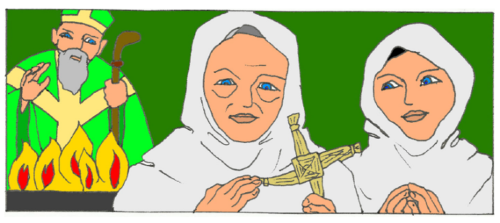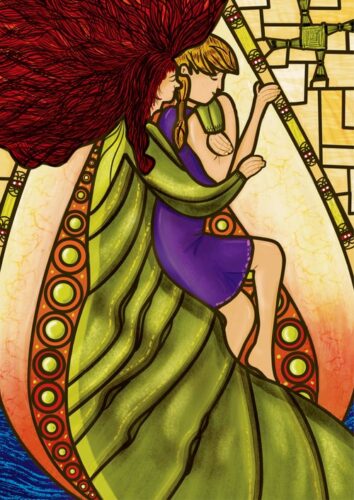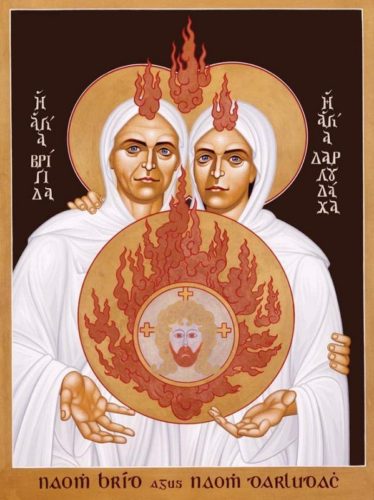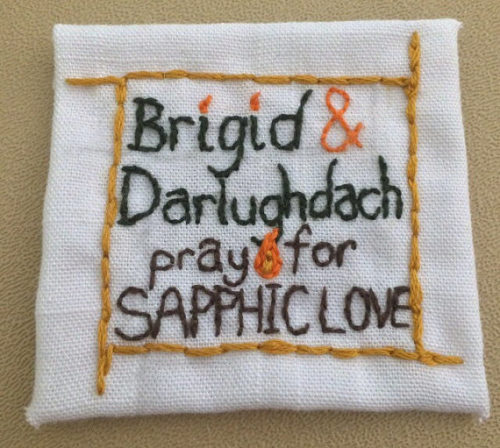Last Updated on January 31, 2025 by Kittredge Cherry
Brigid of Kildare and her soulmate Darlughdach were sixth-century Irish nuns who brought art, education and spirituality to early medieval Ireland. They each served as abbess in Kildare with authority over several monasteries. Brigid (c. 451-525) shares her name and feast day (Feb. 1) with a Celtic goddess — and she may have been the last high priestess of the goddess Brigid. Her followers still keep a flame burning for her.
In 2023 the Irish government added Saint Brigid’s Day as a new national holiday, the first to be named after a woman.
Raised by Druids, Brigid seems to have made a smooth transition from being a pagan priestess to a Christian abbess. Since medieval times Brigid has been called “Mary of the Gael” because of her similarity to Christianity’s central holy woman. Today she is Ireland’s most famous female saint. Her name is also spelled Bridget. Legend says that when she made her final vows as a nun, the bishop in charge was so overcome by the Holy Spirit that he administered the rite for ordaining a (male) bishop instead.

Brigid holds a Brigid’s Cross beside her soulmate Darlughdach in an image from the book “Heavenly Homos, Etc.: Queer Icons from LGBTQ Life, Religion, and History” by Jan Haen, a Dutch artist and priest.
A younger nun named Darlughdach served as Brigid’s ambassador and her “anam cara” or soul friend. She is also known as Dar Lugdach, Der Lugdach or Dharlughdach, and venerated in Bavaria as Dardalucha. The two women were so close that they slept in the same bed. Like many Celtic saints, Brigid believed that each person needs a soul friend to discover together that God speaks most powerfully in the seemingly mundane details of shared daily life. The love between these two women speaks to today’s lesbians and their allies. Some say that Brigid and Darlughdach are lesbian saints. An LGBT group for women and non-binary people in Ireland is named Daughters of Darlughdach.
Their relationship was put into a contemporary pop-culture context in an article by queer media critic Jessica Mason:
“It was a very Xena and Gabrielle situation. They slept in the same bed, they lived and worked together, and one time when Brigid caught Darlughdach looking at a male warrior and made Darlughdach walk with hot coals in her shoes as penance,” she wrote.
Brigid started convents all over Ireland and became the abbess of the “double monastery” (housing both men and women) at Kildare. Built on land that was previously sacred to her divine namesake, the monastery included an art school for creating illuminated manuscripts.
After Brigid turned 70, she warned Darlughdach that she expected to die soon. Her younger soulmate begged to die at the same time. Brigid wanted her to live another year so she could succeed her as abbess. Brigid died of natural causes on Feb. 1, 525. The bond between the women was so close that Darlughdach followed her soulmate in death exactly one year later on Feb. 1, 526.
Celebrations of Saint Brigid
Both Christians and pagans celebrate St. Brigid’s Day on Feb. 1. Brigid is honored as a saint in the Catholic, Anglican and Eastern Orthodox traditions. People still celebrate her day by weaving twigs into a square “Brigid’s Cross,” an ancient solar symbol traditionally made to welcome spring. Feb. 1-2 is also known as Imbolc, a spring festival when the goddess Brigid returns as the bride of spring in a role similar to the Greek Persephone. Imbolc has been adapted not only into St. Brigid’s Day on Feb. 1, but also as Candlemas on Feb. 2. Brigid is associated with sacred flames, not unlike the candles that burn in Candlemas processions In many countries Candlemas festivities focus on Mary and the sacred feminine, including the Madonna of Montevergine who rescued a queer couple in medieval times.
Brigid’s main symbol was fire, representing wisdom, poetry, healing and metallurgy. The nuns at the Kildare monastery kept a perpetual fire burning in Brigid’s memory for more than a thousand years — until 1540 when it was extinguished in Henry VIII’s Dissolution of the Monasteries.
The Order of St. Brigid was reestablished in 1807. Two Brigidine sisters returned to Kildare and relit the fire in the market square for the first time in more than 400 years on Feb. 1, 1993. The perpetual flame is now kept at the Solas Bhride (Brigid’s Light) Celtic Spirituality Center that they founded there. In addition, anyone may light a virtual candle or sign up to tend St. Brigid’s flame in their own homes through the Ord Brighideach Order of Flame Keepers.
Brigid and Darlughdach in art
Images of Brigid and Darlughdach together are rare, but a few artists have cared or dared to portray the female soulmates together. They are shown with their arms around each other and a double halo in an icon by Robert Lentz at the top of this post. He is a Franciscan friar and world-class iconographer known for his progressive icons. The two women are dressed in the white gowns worn by Druid priestesses and Celtic nuns. Flames burn above them and on the mandala of Christ that they carry. It is one of 40 icons featured in his book Christ in the Margins. Prints are available through Amazon and Trinity Stores.
The icon was commissioned by the Living Circle, a Chicago-based interfaith spirituality center for the LGBTQ community and allies. Four Living Circle members took the original icon to Kildare with them in 2000 for the flame-lighting ceremony at the recently excavated site of Brigid’s ancient fire temple.
Dennis O’Neill, the priest who founded the Living Circle, includes the icon and an in-depth biography of Brigid and Darlughdach in his book “Passionate Holiness: Marginalized Christian Devotions for Distinctive People.”

“The Love Between St. Brigid and Darlughdach” by Charlene McKee from Herstory Festival of Light
Brigid’s long red hair flares as she embraces her beloved Darlughdach in an artwork that looks like a stained-glass window. “The Love Between St. Brigid and Darlughdach” by Charlene McKee was introduced at the 2023 Herstory Festival of Light in Ireland. The traveling festival was sponsored by Herstory, a multi-disciplinary movement celebrating Irish women. It is based on the style of An Tur Gloine, an internationally renowned 20th-century stained-glass studio in Dublin.

“Saint Brighid and Darlughdach of Kildare” by Rowan Lewgalon and Tricia Danby)
Two Celtic Christian artists based in Germany collaborated on the sensuously spiritual portrait of Brigid and Darlughdach at the top of this post. On the left is Darlughdach, painted as a fiery redhead by Rowan Lewgalon, and on the right is fair-haired Brighid, painted by Tricia Danby. Lewgalon and Danby are both clerics in the Old Catholic Apostolic Church as well as spiritual artists.
“Saint Bridget” is one of 39 historical and mythological women featured in “The Dinner Party,” an installation artwork by feminist artist Judy Chicago. Considered a milestone in 20th-century art, it consists of a triangular table with elaborate place settings for each woman. The place settings include embroidered runners, gold chalices and utensils, and hand-painted china plates with a raised vulva or butterfly form. Every item is crafted in a unique style that reflects the woman being honored. In the place setting for “Saint Bridget” at “The Dinner Party,” Celtic and Christian iconography weave together with colorful abstract flames, a modified Celtic cross and a Celtic knot motif.
Brigid and Darlughdach in music
Attention usually focuses on Brigid, but an Irish singer-songwriter gives voice to the saint’s often-overlooked soulmate in “Darlughdach’s Song” (Amhrán Dharlughdach), a mysteriously ethereal ballad in Celtic style. Preparing to reunite after death with the great love of her life, Darlughdach reveals her longing with haunting lyrics such as:
“In death we share our feast day
As in life we shared our bed
Woman, priestess, goddess, saint,
my soul friend once said:
‘One without a soul friend
Is a body without a head.’”
The song was written for the 2021 Liverpool Arts Festival by Ciara Ní É, an Irish poet, performer and activist who a cofounded the queer arts collective AerachAiteachGaelach (GayQueerIrish). She performs it on bilingual videos with Aoife Ní Mhórdha: One is primarily in English, while the other is mostly in Irish with English subtitles. The videos imagine how the soulmates may have spent time together: swimming in the ocean, walking in nature, weaving crosses, and enjoying firelit moments.
Saint Brigid prayers
Q Spirit’s Litany of Queer Saints includes this line:
“Saint Brigid and Saint Darlughdach, women soulmates whose life together was aflame with the Holy Spirit, pray for us.”
Various prayers to Saint Brigid are in circulation, including “Brigid and Darlughdach, pray for Sapphic love.” The prayer was hand-sewn onto an LGBTA+ Patron Saints embroidered patch by artist Avery Smith of Louisville, Kentucky. Smith runs an Etsy shop called Sapphic Stitches (renamed NeuroqueerCrafting) that offers a variety of patches on LGBTA+ Christian and other themes. “Brigid and Darlughdach, pray for Sapphic love” was one of the “LGBTA+ patron saints” patches there.
“LGBTA+ Christians who choose to pray for the intercession of Saints deserve to have patrons whom they trust understand and support them,’Smith affirms. “Whatever Saint or paired-Saint couple resonates with you as an LGBTA+ Christian can be made into a customizable patch!”
Brigid’s spirit of fun and hospitality is expressed in her reputation for loving beer. She made beer for the poor every Easter. In a well known poem attributed to Brigid, she envisioned heaven as a great lake of beer. Here are some of the words to St. Brigid’s Prayer, as translated and performed by Irish singer Noirin Ni Riain:
I’d sit with the men, the women of God
There by the lake of beer
We’d be drinking good health forever
And every drop would be a prayer.
Riain also sings a heavenly Ode To Bridget on the video below and on her Celtic Soul album.
Brigid and Darlughdach are honored as the focus of an Inclusive Liturgy for LGBT History Month created in 2019 by Sam McBratney of Dignity and Worth, a group of British Methodists. It features the following collect or short prayer for church use on a particular day.
Merciful God, source of all loving kindness,
you called Saint Brigid and Saint Darlughdach
to teach the new commandment of love
through their life together of hospitality and care;
may their example inspire in us
a spirit of generosity and a passion for justice
that, in our hearts and lives,
all may witness your fearless love:
Through Jesus Christ, your Living Word,
in the power of the Holy Spirit.
Amen.
The liturgy ends with a solemn blessing, including these lines:
Solemn Blessing
May God, who in Brigid and Darlughdach, has provided
us the example of generosity, companionship and care:
keep your ears ever open
to the cry of the poor and excluded….
Links related to Brigid and Darlughdach
The Transcendent Tale of Brigid of Ireland: Celtic Goddess, Catholic Saint… (blessedarethebinarybreakers.com)
Queer holiness and human longing for transformation: a reflection by Josephine Inkpin for Midsumma (Melbourne LGBTI+) Festival, on the feast of Brigid & Darlughdach, Feb. 1, 2019
Meet Brigid, the Irish Goddess, Saint, Lesbian Icon, and a Voodoo Loa (TheMarySue.com)
___
To read this article in Spanish, go to:
Santa Brigid y Darlughdach: Irlandés santo amaba a su alma amiga (Santos Queer)
To read this article in Italian, go to:
Il fuoco di Santa Brigida e la sua anima gemella. Due monache nell’Irlanda medioevale (gionata.org)
To read this article in Russian, go to:
Святая Бригитта Ирландская и ее «подруга души» святая Дарлугдах (nuntiare.org)
To read this article in Persian / Farsi, go to:
بریجید و همدم روحی (سول میت) اش دارلوداک دو راهبه ی ایرلندی قرن ششم بودند (anastasius_sacredheart)
Lesbian nuns from history
Q Spirit’s LGBTQ Saints series includes the following lesbian nuns:
Jeanne Cordova: Lesbian nun who “kicked the habit” to be an activist
Hildegard of Bingen and Richardis: Medieval mystic and the woman she loved
Sor Juana Inés de la Cruz: Nun who loved a countess in 17th-century Mexico City
Walatta Petros: African nun shared a lifetime bond with a female partner in 17th-century
Books related to lesbian nuns
“Nun Better: An Amazing Love Story” by Joanie Lindenmeyer and Carol Tierheimer. Published by Two Sisters Writing and Publishing, 2023.
“Love Tenderly: Sacred Stories of Lesbian and Queer Religious,” edited by Grace Surdovel (2021). Published by New Ways Ministry.
“Immodest Acts: The Life of a Lesbian Nun in Renaissance Italy” by Judith C. Brown
“Lieutenant Nun: Memoir of a Basque Transvestite in the New World” by Catalina De Erauso
“Lesbian Nuns: Breaking Silence” by Nancy Manahan and Rosemary Keefer Curb (editors)
___
Top image credit:
“Saints Brigid and Darlughdach of Kildare” by Robert Lentz. Prints are available through Amazon and Trinity Stores.
___
This post is part of the LGBTQ Saints series by Kittredge Cherry. Traditional and alternative saints, people in the Bible, LGBTQ martyrs, authors, theologians, religious leaders, artists, deities and other figures of special interest to lesbian, gay, bisexual and transgender and queer (LGBTQ) people and our allies are covered.
This article has evolved and expanded greatly since the first version was posted in February 2010. It was published on Q Spirit in January 2017, was enhanced with new material over time, and was most recently updated on Jan. 31, 2025.
Copyright © Kittredge Cherry. All rights reserved.
Qspirit.net presents the Jesus in Love Blog on LGBTQ spirituality.























Anamcara didn’t mean soulmate at that time, it meant spiritual advisor or confessor. Nothing I have found before Dinneen’s dictionary in 1904 renders it as Soul friend. http://www.dil.ie/search?q=anamcara
Thank you for your article on Saint Brigid and Saint Darlughdach. I’m Catholic and really love learning anything new about the saints. Please keep me on your mailing list!
Thanks, Ellen! I just added you to the email list to for the monthly Q Spirit newsletter.
A “soul friend” was not the same as a romantic “soulmate”, and the only other “evidence” of a lesbian relationship between Darlughdach and Brigid was the nearly universal medieval practice of sleeping with multiple people to a bed, sometimes entire families. Hence you’d need to claim that most of the population were homosexual or incestuous.
You really think two nuns are stupid enough to be outspoken lesbians lmao even NOW, that’s incredibly dangerous, let alone in centuries past. Read “Kicking the Habit” by Jeanne Cordova, an ex-nun lesbian activist, to learn what life is actually like on the inside of a convent – especially for someone who deals with same-sex attraction. To believe that every single priest, monk, nun, etc. were all 100% celibate/straight – let alone good people, – is so wildly ignorant and naive that my only response to you is to grow up and properly educate yourself on history and reality. The fact that you can’t even handle people debating their identity/sexuality in the first place to the point that you are furiously spamming literally every single article on this website that I come across is so pathetic and sad that maybe you need to spare some prayers for yourself, sweetie.
This is a reply to the person calling themselves “Your mom” since the system doesn’t let me reply directly to a previous reply.
You still haven’t presented any evidence that these two specific nuns were romantically involved, and your personal attacks against me are childish. I don’t assume that all cloistered clergy were celibate, but in this case there’s no evidence that they violated their vows of celibacy.
The etymology of the word “amancara” is fairly simple once you put it in context. “Aman,” translated from Gaelic, literally means “soul,” and “chara,” translated from Gaelic, literally means friend. So, to put it together, it literally means “soul friend.” There are different connotations to it, so you are correct about this. It can also mean “spiritual advisor” or “confessor.” When you look at the timeline of Brigid’s and Darlughdach’s relationship, there is a pattern that can be found in many male-male relationships of the time that might fall under a certain type of friendship/love as explained by Plato, the Greek philosopher, and Cicero, the Roman orator.
They believed that the best kind of love was one that did not involve sex and one that lifted the souls of the lovers through a mutual bond revolving around virtue. It somewhat resembles the Greek practice of pederasty, minus the extreme age gaps and sexual activity. Brigid certainly was Darlughdach’s spiritual advisor. When older religious figures took younger people under their wings, it was because they felt that mutual bond and wished to impart on them wisdom and to be able to connect to God through one another.
This is a notion that was carried on into late Antiquity and through the Middle Ages. When people talk about sexuality, they often forget about the half that involves love due to the name. You do not have to have sex to express love for your partner, which is something that has been lost on us in the modern world.
Sorry, forgot to put my citations.
Citations: My Master’s degree in medieval European history with a focus on sexuality studies
This is a reply to McKenzie since the system doesn’t allow a direct reply to another reply.
You wrote: “Brigid certainly was Darlughdach’s spiritual advisor. When older religious figures took younger people under their wings, it was because they felt that mutual bond and wished to impart on them wisdom”, which was precisely my position. Serving as a spiritual advisor does not mean romance (which is what the article was claiming by saying “Some say that Brigid and Darlughdach are lesbian saints”), in fact a spiritual advisor is expected to avoid romance. BTW, during the last few days I’ve been bombarded with replies to me on this site (after a hiatus of several months with virtually no replies), first by someone calling themselves “Your Mom” and then by “McKenzie”. Are you the same person?
I changed the settings for this blog to hopefully make it easier to reply directly to a reply. Behind the scenes here at Q Spirit, it looks like McKenzie and “Your Mom” are two different people. At least they have two different email addresses. I’m glad to see some new people commenting here!
I had such a powerfull reconection reading this.
I am so grateful for your work.
Sending lots of love and pure energy here from Brazil
<3
This is so beautiful and inspiring- Thank you so much for providing a space to truly feel joy and connect spiritually without sacrificing authenticity! This site makes me smile and I appreciate your work and passion for the greater good of all beings and celebrating and connecting among our beautiful differences!
Thank you, Whitney! Your comment warms my heart, so I added it to the “What Others are Saying” section of this website. I hope you’ll come back again often for more inspiration.
Hello Kittredge Cherry,
The story of Saint Bridget brought tears in my eyes, thank you so much for sharing it! It is true that soulmates are not on Earth only to be emotionally and spiritually close to us but to assist us on our divine mission as well. Thank you for the lovely video as well. Bless you!
Zaria